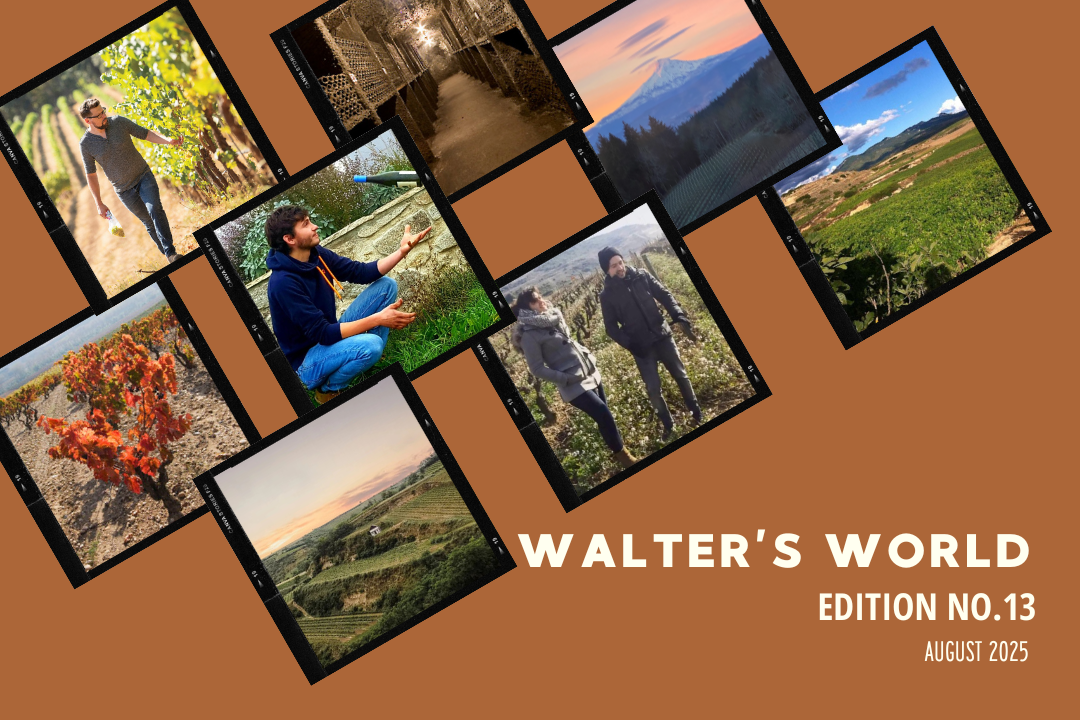Walter's World, Edition No. 13 (August 2025)

So, I [Jess] have been nudging Chris for officially a year now (happy birthday, Walter’s World!) to add just a tiny bit of structure to each release. Instead of going purely “seasonal,” maybe we could spend some months focusing on certain regions or aspects of the wine world. Well, this month I finally got my wish — we have a theme!
It all started when Chris and I were talking about what special bottles we could pull from the shop as our one-year rolled around. For the anniversary party we poured the López de Heredia ‘Bosconia’ by the glass, and everyone loved it. Then we spotted some extra López de Heredia Cubillo in the bins and got excited to share it with you. When we tasted the Bodegas Moraza Rioja, Chris commented how different it was than López and how it would be interesting to try them side-by-side. “Wine club?” I said, and here we are. 🙂
This month, we’re doing a side-by-side comparison of Grüner Veltliner — one from Austria [in alternative packaging!] and one from the Columbia Gorge — plus a comparison of two very different styles of Rioja: the legendary and the new guard. We hope you find this journey as fun and interesting as we did!
Cheers,
the Walter’s team
PS – Two-bottle members, let us know if you’d like to snag the other two bottles for the side-by-side!
I | Gorgiste Grüner Veltliner
2023 | Columbia Gorge, Washington | 100% Grüner Veltliner
This label is the Columbia Gorge AVA focused efforts of W.T. Vintners, a sommelier turned winemaker named Jeff Lindsay-Thorsen who works out of Woodinville. Jeff and I were on the opening sommelier team at RN74 downtown back in 2011 which was a Burgundy focused program with an amazing collection of older vintages and hard to find producers. While he makes Washington wine and largely focuses on Syrah, his secret crush has always been on Austria’s Gruner Veltliner for its amazing texture and versatility with food. The problem was that there was little to none planted in the state that he could find... until James & Poppy Mantone of Syncline winery tipped him off to some plantings in the Underwood Mountain vineyard in the Columbia Gorge. He jumped on buying as much as the grower would sell him, and this wine quickly became a big part of the identity of W.T.
In the process, he discovered more gems in the Gorge that aligned with his preferences for styles and varieties, which led him to create the Gorgiste label.
This Gruner spends 36 hours on the skins to create texture and highlight the natural spice of daikon, wasabi, and arugula that is unique to the variety. For the aging, about ¾ goes into stainless steel while the remainder spends its time in a concrete egg. These vessels make a distinct impression on wines as the shape of the egg encourages a natural, gentle stirring of the lees (dead yeast cells and fine grape matter) which further highlights texture, and the concrete itself generally lends more “minerality” and tension to the wine as well.
We picked this wine because it’s such an amazing expression of the variety that would fit into a lineup of Austrian examples while still capturing the magic of the Gorge. If you can, taste it side by side with the Bauer also included in this month’s club and you’ll see what I mean! In terms of food, I’d drink this with summer corn, a bean salad, or something akin to Wiener schnitzel, of course.
II | Bodegas Moraza San Vicente de la Sonsierra
2022 | Rioja Alta, Spain | 100% Tempranillo
There’s a bit of a revolution going on in Rioja at the moment which is really exciting as it’s There’s a bit of a revolution going on in Rioja at the moment, which is really exciting as it’s created a greater palette of wines to experience. Tradition is important, and, in the case of Rioja, also tasty in a savory way, but sometimes you just want something that is refreshing, crunchy, and lip smacking you know? That’s this wine. Farmed biodynamically from old en vaso (freestanding) self sufficient vines in San Vicente de las Sonsierra by the sixth generation, this wine really shows off the variety of Tempranillo rather than the aging process that you’ll experience in the Lopez de Heredia. Neither is better, just different.
The Lopez spends many years in barrel, way more than the requirement of law for the style, which transforms the wine into a perfumed & complex beautiful beast. The Moraza spends a short time in concrete after being fermented with native yeast in efforts to further capture the sense of place. The result is tart cherry, savoury herbs, and baked earth minerality with pretty incredible length. We highly recommend you give this wine a splash decant about 30 minutes before drinking it as it can be a bit shy out of the gate!
III | Norbert Bauer ‘schplïnk!’
2024 | Weinviertel, Austria | 100% Grüner Veltliner
Calm down! Before you judge this wine by its container, pop the box in your fridge and have a glass or three, and I bet you’ll be a happy camper.
Alternative packing has come a long way in the last decade, and I think it’s an important consideration for the wine business moving forward. Wine growing and winemaking are pretty sustainable practices with vines requiring far less water than say soybeans or almonds, but the shipping of wine in heavy glass bottles around the world really changes its carbon footprint. While I’m not going to give up my Grand Cru, Champagne, or Spanish Garnacha anytime soon, I am always looking for good everyday drinkers like this one that can offer an option to tread a bit lighter while also offering the convenience of having something tasty chilled and ready to rock whenever the schneckons beckons (cue Nathan Lane in a sunhat on a Danube river cruise).
The Bauers have been making wine in Austria since 1721 in the Weinviertel, a region to the north of Vienna on the border of the Czech Republic in the town of Jetzelsdorf on the Pulkau river. Norbert and his wife Gisela are the current stewards of this organically farmed vineyard. For this wine, they teamed up with New York-based Master of Wine Melissa Monti Saunders of Communal Brands, a company Melissa started to focus on luxury boxed wine back in 2016 after writing her MW thesis on the subject. Her aim is to change the perception of the alternative packaging and do some good for the environment in the process.
This wine is made similarly to the Gorgiste where it spends about 12 hours on the skins and is then aged in stainless steel, so the major difference is the lack of concrete egg.
Added bonuses of this selection?? It’s 4 freaking bottles! And the box design is inspired by Kraftwerk - what could be better?
IV | López de Heredia ‘Viña Cubillo’
2016 | Rioja, Spain | 65 % Tempranillo, 25% Garnacho, Mazuelo & Graciano
property in all of Rioja as it has so much history but also has conscientiously made efforts to modernize itself in the right ways, not by changing the wine but by the way they connect with the wine community, which I appreciate.
The winery itself has been around since 1877 and has been farming their flagship site of “Tondonia” since the early 1900s making both white and red at Reserva and Grand Reserva levels. We recently were allocated the 2004 Tondonia Blanco Grand Reserva, and it blew us away. It’s hard to describe this wine as it has flavors that only a very complex aging process could create. That’s how all their wines are as they always go above and beyond with their cellar work to make really incredible wines.
This one hails from the Cubillo vineyard and is considered by tradition to be for earlier drinking but that’s pretty relative considering the current release is the 2016 vintage. The wine is vinified in ancient large wooden tanks and then spends 3 years in barrel and another 5 or so in bottle. The cellars are dank, dark, and have crazy looking mold everywhere with pockets of what looks to be ectoplasm from another dimension. Here the bottles do their thing for 5, 15, or in some rare cases, 50 years before release.
Cubillo is full of pipe tobacco, soy, mushrooms, craisins, spice, and desiccated strawberries and, and, and. I could go on but just taste it for yourself. I’ll bet it invokes some memory through the myriad of unexpected aromas. This wine needs food though, and a simple braise would be perfect when the weather cools.
